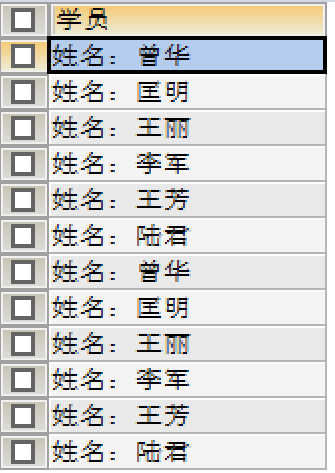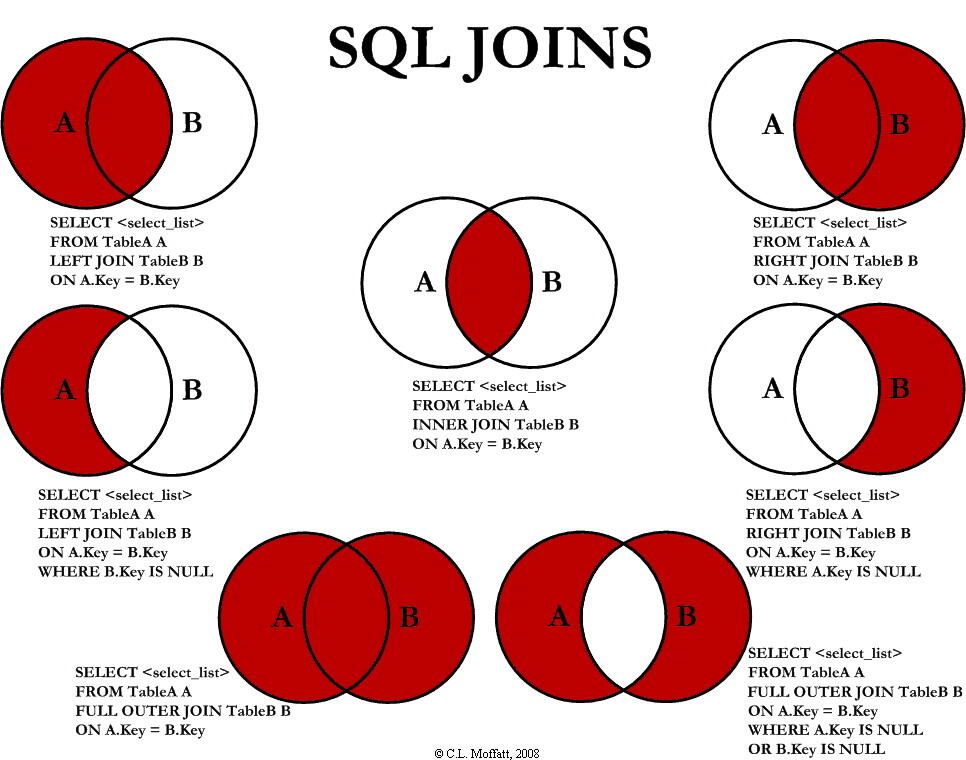sql-3-DML_DQL
DML-操作数据
1、insert语句
--增加一行数据
insert into 表名([字段1,字段2,字段3,...])values('值1','值2','值3',...);
insert into student values('108','曾华','男','1977-09-01','95033');
-- 不加字段,数据会顺序对应table中的字段
-- 增加多行数据
insert into 表名([字段1,字段2,字段3...])
values('xx','xx','xx',...),
('xx','xx','xx',...),
('xx','xx','xx',...);
insert into student
values('108','曾华','男','1977-09-01','95033'),
('105','匡明','男','1975-10-02','95031'),
('107','王丽','女','1976-01-23','95033'),
('101','李军','男','1976-02-20','95033'),
('109','王芳','女','1975-02-10','95031'),
('103','陆君','男','1974-06-03','95031');
2、delete语句
delete from 表名
where 条件;
truncate和delete清空表单区别:
-- truncate 表名;清空这个表,可以理解为删除这个库再创一个,而且自增会归零
-- delete清零:
1、innodb:重启数据库会导致自增重新开始,记录存在内存中
2、myisam:重启数据库仍按原来的自增进行,记录在文件中
3、update语句
--注意where语句,不加这个字段的数据都会更新
update 表名s
set 字段='值1',[字段2='值2',,,]
where id='要修改的那一行的id';
-- where条件:
1、=,<>,!=,>,<,<=,>=,
2、between ... and ... ---注意这里是闭区间
3、and,or
DQL-查询数据
- 新关键词
- select
- distinct
- where
- like
- in
1、select总概语法
- 注意:select之后接上的是一个表达式(可以包含函数,加减乘除法)
select [ALL | DISTINCT]
{*| table.* | [table.flied1[as alisa1][,table.flies2[as alias2]][.....]]}
from table_name [as table_alias]
[left | right | inner join table_name2] -- 联表查询
[where ...] -- 指定结果需满足的条件
[group bg] -- 指定结果按照那几个字段来分组
[having] -- 过滤分组必须满足的次要条件
[order by ...] -- 指定查询记录按一个或多个条件排序
[limit {[offset,]row_count | row_countoffset offset}]; -- 查询的结果分页
2、准备好要演示用的数据表
create database if not exists `school`;
-- 创建一个school数据库
use `school`;-- 创建学生表
drop table if exists `student`;
create table `student`(
`studentno` int(4) not null comment '学号',
`loginpwd` varchar(20) default null,
`studentname` varchar(20) default null comment '学生姓名',
`sex` tinyint(1) default null comment '性别,0或1',
`gradeid` int(11) default null comment '年级编号',
`phone` varchar(50) not null comment '联系电话,允许为空',
`address` varchar(255) not null comment '地址,允许为空',
`borndate` datetime default null comment '出生时间',
`email` varchar (50) not null comment '邮箱账号允许为空',
`identitycard` varchar(18) default null comment '身份证号',
primary key (`studentno`),
unique key `identitycard`(`identitycard`),
key `email` (`email`)
)engine=myisam default charset=utf8;
-- 创建年级表
drop table if exists `grade`;
create table `grade`(
`gradeid` int(11) not null auto_increment comment '年级编号',
`gradename` varchar(50) not null comment '年级名称',
primary key (`gradeid`)
) engine=innodb auto_increment = 6 default charset = utf8;
-- 创建科目表
drop table if exists `subject`;
create table `subject`(
`subjectno`int(11) not null auto_increment comment '课程编号',
`subjectname` varchar(50) default null comment '课程名称',
`classhour` int(4) default null comment '学时',
`gradeid` int(4) default null comment '年级编号',
primary key (`subjectno`)
)engine = innodb auto_increment = 19 default charset = utf8;
-- 创建成绩表
drop table if exists `result`;
create table `result`(
`studentno` int(4) not null comment '学号',
`subjectno` int(4) not null comment '课程编号',
`examdate` datetime not null comment '考试日期',
`studentresult` int (4) not null comment '考试成绩',
key `subjectno` (`subjectno`)
)engine = innodb default charset = utf8;
-- 插入学生数据 其余自行添加 这里只添加了2行
insert into `student` (`studentno`,`loginpwd`,`studentname`,`sex`,`gradeid`,`phone`,`address`,`borndate`,`email`,`identitycard`)
values
(1000,'123456','张伟',0,2,'13800001234','北京朝阳','1980-1-1','text123@qq.com','123456198001011234'),
(1001,'123456','赵强',1,3,'13800002222','广东深圳','1990-1-1','text111@qq.com','123456199001011233');
-- 插入成绩数据 这里仅插入了一组,其余自行添加
insert into `result`(`studentno`,`subjectno`,`examdate`,`studentresult`)
values
(1000,1,'2013-11-11 16:00:00',85),
(1000,2,'2013-11-12 16:00:00',70),
(1000,3,'2013-11-11 09:00:00',68),
(1000,4,'2013-11-13 16:00:00',98),
(1000,5,'2013-11-14 16:00:00',58);
-- 插入年级数据
insert into `grade` (`gradeid`,`gradename`) values(1,'大一'),(2,'大二'),(3,'大三'),(4,'大四'),(5,'预科班');
-- 插入科目数据
insert into `subject`(`subjectno`,`subjectname`,`classhour`,`gradeid`)
values
(1,'高等数学-1',110,1),
(2,'高等数学-2',110,2),
(3,'高等数学-3',100,3),
(4,'高等数学-4',130,4),
(5,'C语言-1',110,1),
(6,'C语言-2',110,2),
(7,'C语言-3',100,3),
(8,'C语言-4',130,4),
(9,'Java程序设计-1',110,1),
(10,'Java程序设计-2',110,2),
(11,'Java程序设计-3',100,3),
(12,'Java程序设计-4',130,4),
(13,'数据库结构-1',110,1),
(14,'数据库结构-2',110,2),
(15,'数据库结构-3',100,3),
(16,'数据库结构-4',130,4),
(17,'C#基础',130,1);
INSERT INTO `subject`(`subjectno`,`subjectname`,`classhour`,`gradeid`)
values
(1,'高等数学-1',110,1),
(2,'高等数学-2',110,2),
(3,'高等数学-3',100,3),
(4,'高等数学-4',130,4),
(5,'C语言-1',110,1),
(6,'C语言-2',110,2),
(7,'C语言-3',100,3),
(8,'C语言-4',130,4),
(9,'Java程序设计-1',110,1),
(10,'Java程序设计-2',110,2),
(11,'Java程序设计-3',100,3),
(12,'Java程序设计-4',130,4),
(13,'数据库结构-1',110,1),
(14,'数据库结构-2',110,2),
(15,'数据库结构-3',100,3),
(16,'数据库结构-4',130,4),
(17,'C#基础',130,1);
3、查询字段下的数据
--展示student表的全部字段下的数据
select * from student;
--查询特定字段,注意这里的别名可以直接使用中文。
select `studentno` [as 别名],`studentname` [as 别名] from `student`;
--配合函数使用
select concat('姓名:',studentname) [as 别名] from `student`;
SELECT CONCAT('姓名:',sname)AS 学员 FROM student;效果如下

4、去重(distinct)
-- 去除select查出来的重复数据
select ditinct `studentno` from `student`;
5、select 其他查询作用
select varsion() --查询系统版本
select 100*3-1 as 计算结果 --用来计算
select @@auto_increment_increment --查询自增的步长
select `studentno`,`studentresult`+1 as 提分后 from result;
6、where
- 逻辑运算符
| 与 | and ,&& |
|---|---|
| 或 | ||,or |
| 非 | !,not |
- 模糊查询-like用法
select `studentno`,`studentname` from `student`
where `studentname` like '刘'; --匹配名字里有刘的人
select `studentno`,`studentname` from `student`
where `student` like '刘__'; --匹配叫刘某某的人
select `studentno` , `studentname` from `student`
where `studdent` like '刘%'; --匹配性刘的人
- in用法
select `studentno`,`studentname` from `student`
where `studentno` in (1001,1002,1003); --只匹配学号是1001,1002,1003的同学
7、联表查询(join)
- 联表查询是经常用到的一种语法,非常重要。

-- join语法
SELECT a.runoob_id, a.runoob_author, b.runoob_count
FROM runoob_tbl a
INNER JOIN tcount_tbl b
ON a.runoob_author = b.runoob_author;
了解:
inner join 表示必须要两个表都满足才能输出
right join 表示以右表为基准,而左表中的数据必须要满足后面的条件才能输出
left join 表示以左表为基准,而右表中的数据必须要满足后面的条件才能输出
- 自联接
select a.name as '父栏' ,b.name as '子栏'
from `biao` as a,`biao` as b
where a.id = b.parentid;
-- 实质:将一个表看成两个表进行操作
-- 条件是前一个表的id会等于后面表的parent_id;
8、分页和排序
--在前面加上我们的select语句
排序:
order by `字段` asc;
-- asc(cending)升序,desc(cending)降序
分页:
limit 5,5
-- 两个数据的意思:
-- 跳过多少个数据,显示几个数据
-- 第一页:limit 0,5;
-- 第二页:limit 5,5;
-- 第三页:limit 10,5;
9、子查询和嵌套查询
sql-3-DML_DQL的更多相关文章
- 最近帮客户实施的基于SQL Server AlwaysOn跨机房切换项目
最近帮客户实施的基于SQL Server AlwaysOn跨机房切换项目 最近一个来自重庆的客户找到走起君,客户的业务是做移动互联网支付,是微信支付收单渠道合作伙伴,数据库里存储的是支付流水和交易流水 ...
- SQL Server 大数据搬迁之文件组备份还原实战
一.本文所涉及的内容(Contents) 本文所涉及的内容(Contents) 背景(Contexts) 解决方案(Solution) 搬迁步骤(Procedure) 搬迁脚本(SQL Codes) ...
- Sql Server系列:分区表操作
1. 分区表简介 分区表在逻辑上是一个表,而物理上是多个表.从用户角度来看,分区表和普通表是一样的.使用分区表的主要目的是为改善大型表以及具有多个访问模式的表的可伸缩性和可管理性. 分区表是把数据按设 ...
- SQL Server中的高可用性(2)----文件与文件组
在谈到SQL Server的高可用性之前,我们首先要谈一谈单实例的高可用性.在单实例的高可用性中,不可忽略的就是文件和文件组的高可用性.SQL Server允许在某些文件损坏或离线的情况下,允 ...
- EntityFramework Core Raw SQL
前言 本节我们来讲讲EF Core中的原始查询,目前在项目中对于简单的查询直接通过EF就可以解决,但是涉及到多表查询时为了一步到位就采用了原始查询的方式进行.下面我们一起来看看. EntityFram ...
- 从0开始搭建SQL Server AlwaysOn 第一篇(配置域控)
从0开始搭建SQL Server AlwaysOn 第一篇(配置域控) 第一篇http://www.cnblogs.com/lyhabc/p/4678330.html第二篇http://www.cnb ...
- 从0开始搭建SQL Server AlwaysOn 第二篇(配置故障转移集群)
从0开始搭建SQL Server AlwaysOn 第二篇(配置故障转移集群) 第一篇http://www.cnblogs.com/lyhabc/p/4678330.html第二篇http://www ...
- 从0开始搭建SQL Server AlwaysOn 第三篇(配置AlwaysOn)
从0开始搭建SQL Server AlwaysOn 第三篇(配置AlwaysOn) 第一篇http://www.cnblogs.com/lyhabc/p/4678330.html第二篇http://w ...
- 从0开始搭建SQL Server AlwaysOn 第四篇(配置异地机房节点)
从0开始搭建SQL Server AlwaysOn 第四篇(配置异地机房节点) 第一篇http://www.cnblogs.com/lyhabc/p/4678330.html第二篇http://www ...
- SQL Server on Linux 理由浅析
SQL Server on Linux 理由浅析 今天的爆炸性新闻<SQL Server on Linux>基本上在各大科技媒体上刷屏了 大家看到这个新闻都觉得非常震精,而美股,今天微软开 ...
随机推荐
- 开放式神经网络交换-ONNX(上)
目的 本文档包含ONNX语义的规范性规范. "onnx"文件夹下的.proto和.proto3文件构成了用协议缓冲区定义语言编写的语法规范..proto和.proto3文件中的注释 ...
- https ssl(tls)为什么不直接用公钥加密数据?
很多人都提到了非对称加密速度慢,但这只是一个原因,但不是主要原因,甚至是微不足道的原因. SSL协议到3.0后就已经到头了,取而代之的是TLS,相较于SSL的"安全套接字层"的命名 ...
- 用Java如何设计一个阻塞队列,然后说说ArrayBlockingQueue和LinkedBlockingQueue
前言 用Java如何设计一个阻塞队列,这个问题是在面滴滴的时候被问到的.当时确实没回答好,只是说了用个List,然后消费者再用个死循环一直去监控list的是否有值,有值的话就处理List里面的内容.回 ...
- 5.23考试总结(NOIP模拟2)
5.23考试总结(NOIP模拟2) 洛谷题单 看第一题第一眼,不好打呀;看第一题样例又一眼,诶,我直接一手小阶乘走人 然后就急忙去干T2T3了 后来考完一看,只有\(T1\)骗到了\(15pts\)[ ...
- csp-s模拟测试52-53
留坑.... 改完题再说吧. 留坑....最近考得什么鬼??模拟53T1 u(差分) 一道差分题????然而考场没有想到如何维护斜率上的差分,事后经miemeng和cyf的生(xuan)动(xue)讲 ...
- 环境安装——JDK安装
@ 目录 开发环境-JDK安装 1. 下载地址 2. 安装JDK 3. 配置系统环境 开发环境-JDK安装 无论在我们开始学习Java或者入职第一天安装环境,这个你都是必备滴!下面是下载和安装JDK的 ...
- kustomize简单使用
1.背景 在Kubernetes v1.14版本的发布说明中,kustomize 成为了 kubectl 内置的子命令,并说明了 kustomize 使用 Kubernetes 原生概念帮助用户创作并 ...
- lms框架服务注册中心
服务注册中心原理 在分布式系统里的注册中心.原理是将部署服务的机器地址记录到注册中心,服务消费者在有需求的时候,只需要查询注册中心,输入提供的服务名,就可以得到地址,从而发起调用. 在微服务架构下,主 ...
- CMD命令进入某个目录
1.开始->运行->CMD 2.进入某个磁盘,直接盘符代号:如D:,不用CD 命令切换 3.进入除根录以下的文件夹 cd 文件夹路径 例如我要进入 E:/Program Files/PHP ...
- POJ 3449 Geometric Shapes 判断多边形相交
题意不难理解,给出多个多边形,输出多边形间的相交情况(嵌套不算相交),思路也很容易想到.枚举每一个图形再枚举每一条边 恶心在输入输出,不过还好有sscanf(),不懂可以查看cplusplus网站 根 ...
